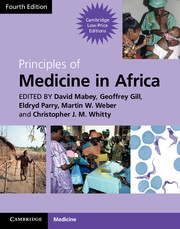Book contents
- Frontmatter
- Contents
- Contributors
- Foreword
- Section 1 Health and disease
- Section 2 Mother and child health
- Section 3 Infection: general principles
- Section 4 Major common infections
- Section 5 Bacterial infections
- 22 Typhoid, paratyphoid and non-typhoid Salmonella infections
- 23 Streptococcus pyogenes and Staphylococcus aureus
- 24 Rickettsial infections
- 25 Brucellosis
- 26 Leptospirosis
- 27 Relapsing fever
- 28 Plague
- 29 Anthrax
- 30 Tetanus
- 31 Diphtheria
- 32 Leprosy
- 33 Cholera
- Section 6 Viral Infections
- Section 7 Protozoal infections
- Section 8 Helminth infections
- Section 9 Fungal infections
- Section 10 Non-communicable diseases
- Section 11 Diseases of body systems
- Section 12 Cancer and Palliative Care
- Section 13 Venoms and Poisons
- Index
- References
23 - Streptococcus pyogenes and Staphylococcus aureus
from Section 5 - Bacterial infections
Published online by Cambridge University Press: 05 March 2013
- Frontmatter
- Contents
- Contributors
- Foreword
- Section 1 Health and disease
- Section 2 Mother and child health
- Section 3 Infection: general principles
- Section 4 Major common infections
- Section 5 Bacterial infections
- 22 Typhoid, paratyphoid and non-typhoid Salmonella infections
- 23 Streptococcus pyogenes and Staphylococcus aureus
- 24 Rickettsial infections
- 25 Brucellosis
- 26 Leptospirosis
- 27 Relapsing fever
- 28 Plague
- 29 Anthrax
- 30 Tetanus
- 31 Diphtheria
- 32 Leprosy
- 33 Cholera
- Section 6 Viral Infections
- Section 7 Protozoal infections
- Section 8 Helminth infections
- Section 9 Fungal infections
- Section 10 Non-communicable diseases
- Section 11 Diseases of body systems
- Section 12 Cancer and Palliative Care
- Section 13 Venoms and Poisons
- Index
- References
Summary
Introduction
Gram-positive bacteria are common commensal bacteria of the skin and mucosal surfaces that can cause disease with clearly defined clinical syndromes. Streptococci are usually penicillin sensitive, while staphylococci are often penicillin resistant. The epidemiology of streptococcal and staphylococcal disease, and in particular patterns of antibiotic sensitivity are not well described across Africa (Lubell et al., 2010; Reddy et al., 2010).
Streptococcal infections
The streptococci are a group of 30 species of bacteria. These are usefully divided according to the appearance of their colonies on blood agar plates. Colonies with a surrounding green pigmented zone (described as alpha-haemolysis) are Streptococcus pneumoniae or one of the large groups of Streptococcus viridans, which are common oral and nasopharyngeal flora only occasionally causing severe disease. Non-haemolytic streptococci are rarely pathogenic. Streptococcal colonies with a surrounding zone of complete haemolysis (clear appearance) are called beta-haemolytic streptococci. These are serologically classified into groups A to H and K to V. Of these, Group A beta-haemolytic streptococci (also known as Streptococcus pyogenes) are by far the most important in causing human disease, and form the subject of this chapter. Some Group B streptococci may cause puerperal sepsis and neonatal infections (including meningitis) in Africa, and Groups C, D and G organisms may cause upper respiratory infections, urinary infections and endocarditis.
- Type
- Chapter
- Information
- Principles of Medicine in Africa , pp. 316 - 322Publisher: Cambridge University PressPrint publication year: 2013



